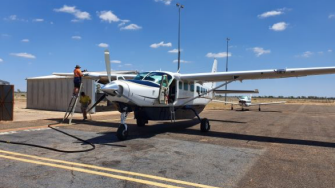
Date: Thursday, October 3, 2019
Project: Eastern Australian Waterbird Survey
Observers: John Porter & Shannon Dundas
Trainee: Amelia Selles
Pilot: Tim Dugan
Day 3 starts with some small dams near Proserpine as a warm up and then we count Lake Proserpine dam – it has hundreds of Eurasian coot, little black cormorants, great cormorant and hardhead ducks. Heading westwards from the landscape becomes progressively drier and more parched – most of the rivers are completely dry or consist of isolated pools.
We find only few birds on the drying creek and river pools near Collinsville– mostly darter, pelicans or cormorants with occasional black or grey teal. As we head further west we reach the Bowen and Burdekin Rivers – at first mainly dry stretches of sand with the occasional small pool of water; then as we continue along the river the pools grow larger and deeper; we encounter only low numbers of birds here – these deep river channels even when full rarely have large numbers of waterbirds.
One of the highlights of this section is the rocky gorges of the Burdekin River below Lake Dalrymple – the water is flowing but again we find few birds – the couple of Jabiru we see are resplendent with their pink legs, black and white bodies and glossy green heads.
Lake Dalrymple has hundreds of little black and great cormorants with lower numbers of egrets, pelicans and darters.
We land at Hughenden for a refuel and welcome break. There are very few wetlands between Hughen and our final destination of Mt Isa – although at one small dam that is shallow and drying we find hundreds of Brolgas – a spectacular site. Our final wetland for the day is Lake Moondarra – it is almost full and has large numbers of waterbirds with high diversity – grebes, herons, ibis ,cormorants, pelicans and lots of hardhead, black duck, grey teal plumed whistling ducks.
